These Fish Finders Can Help Make Your Next Fishing Trip More Bountiful
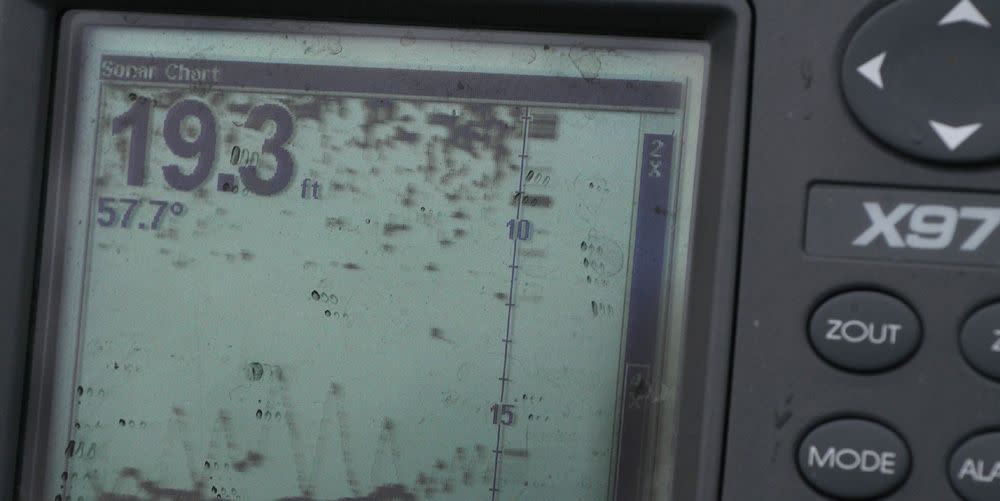
"Hearst Magazines and Yahoo may earn commission or revenue on some items through these links."
If you’re struggling to catch fish, fish finders can feel like a magic bullet ready to solve your problem and fill your creel. While they won’t make up for poor timing or technique, they can be a valuable tool in your tackle box that at worst give you some intel that you didn’t have before.
While most people focus on their fish-finding capabilities, fish finders’ sonar displays are also helpful in showing you the underwater topography and structures that may hold fish. Once you learn how to read the display, a fish finder will become your eyes underwater. It can take you from fishing blind to applying techniques specific to the underwater landscape where you’re fishing.
Beyond just locating fish, these displays also help pinpoint the depths at which fish are congregating, which is especially important in deeper lakes where you could easily be fishing the wrong depth without feedback from your device. You can also usually pick up your line and lure, so you can keep tabs on both the fish and your lure, making fishing much more exciting than simply casting and hoping.
That said, even the most expensive fish finding device can’t catch the fish for you, and you’ll need to apply effective techniques based on the information you get from your device to find success. You’ll want a device that fits your budget and the type of fishing you do, so read on for our top picks as well as tips for choosing the right device for you.
Best Fish Finders
The Expert: As a Colorado-based angler in the Rocky Mountains, I don’t need a fish finder for the trout rivers and streams here like I did growing up catching bass, perch, and walleye in upstate New York’s Finger Lakes. Still, I usually spend a few days each summer there fishing from a boat, and I use a fish finder from my trusty 16-foot aluminum boat on Colorado lakes and reservoirs as well as on the occasional ice-fishing adventure in the winter.
What to Look for in a Fish Finder
Unless you’re ice fishing, you’ll probably want to have some kind of boat or kayak on which to mount a fish finder for the best results. If you don’t have a vessel but want to try your luck with a fish finder, you’ll need to get a castable model that’s meant for shore fishing—and I've highlighted my favorite below. If you’re new to fish finders, you’ll want to make sure to get a user-friendly model because fish finders can be challenging to set up and read for first-timers.
You’ll also want some basic fishing skills and experience on the water before you drop a bunch of cash on a fish finder. It’s tempting for beginners to seek out “cheat codes,” but a fish finder is only useful if you know how to read it and how to react to the information you’re getting about the underwater landscape and the location and behavior of the fish.
Complete Your Fishing Kit: Best Fishing Gear • Best Fishing Rod Holders • Best Waders for Fishing
Cost
Fish finders are expensive, with the best ones costing over $2,000. If you plan to spend that kind of money, you’re likely a dedicated angler who is willing to spend whatever it takes for any advantage over your quarry. The low end of the price range— between about $100 and $200—usually means sacrifices in performance and screen readability, but low-cost fish finders can be a great way to get some experience without committing several mortgage payments to purchase one.
Lower-priced examples can require more practice, better eyes, and more patience, however, than pricier models with better displays and interfaces.
Screen Size
More money typically buys you a bigger, better screen—and bigger is almost always better. A general rule of thumb is to buy the biggest screen you can afford. Most decent models these days have multicolored displays no matter their size, and the color contrast will help you read the information more easily, especially in bright sunlight or if you’re new to using fish finders.
If you’re usually a solo angler, you can get away with a smaller unit, but if you’re fishing in a group, you’ll want everyone to be able to see the screen while fishing; that naturally gets easier with a display that is bigger and clearer. Note: the size of a fish finder screen is measured diagonally, just like laptop and TV screens.
Resolution
Screen size matters, but also look at resolution. Just like when you’re shopping for a TV, you will notice some screens have sharper displays, regardless of the size. Pixels are the measurement that give you the screen’s resolution—or level of detail on the screen— and more pixels are better. More pixels mean more detail and that detail is what will allow you to see fish, structure of the area, and your lure more clearly on the display.
Transducers
Fish finders are made up of two key parts: the display and the transducer. The transducer sends out sonar waves to gather information about the world within the water and projects that info on the screen in a way that's useful for fishing.
You don’t need to understand how these units work exactly, but there are few things to know when evaluating the transducer. First, not any transducer works with any display unit, which is why most displays and transducers are sold as pairs. Don’t try to mix and match your own.
A transducer’s types of sonar beams and those beams’ cone angles determine the type of information displayed. Wider cones cover more territory but are usually lower resolution, so you get less detail. Tighter cones will give more detailed images but only cover a narrow region. This is why many fish finders will have multiple types of sonar and use a split screen to show you a wider region in one display image and a more detailed display in another.
Since even budget fish finders have multiple types of sonar these days, you don’t need to obsess over cone angles because manufacturers cover their bases with multiple cones. If you’re evaluating a fish finder with only one type, don’t look at the cone angle, look at a different model.
Mounting
There are two mounting decisions involved with many fish finders: where to mount the display and where to mount the sonar transducer unit. Mounting the display is generally the easier of the two, as you just need to place it somewhere on your boat or kayak that will be easy to see while you’re actively fishing. Usually, fish finders come with mounting hardware for the display and will often require drilling into a surface for the device to be secure.
Mounting the transducer is a bit more complicated, as the ideal placement can differ depending on the type of transducer as well as by the type of boat. Many fish finders will come with guidance specific to your particular unit, so your best bet is always to follow manufacturer recommendations for mount placement.
Some transducers are “through-hull” and require drilling through your boat’s hull, which should be tackled by a professional. Turbulence, motors, and other equipment on your boat can cause interference, so in general, a good mounting location is one as far away from those potential sources of interference as possible.
Max Depth
The bodies of water you normally fish can affect the type of fish finder you need. Many fish finders are built for medium depth lakes. If you fish at either extreme (really shallow waters or really deep ones), pay attention to the maximum depth of the fish finders you’re considering. If you fish particularly deep lakes, check if the fish finder’s maximum depth matches or exceeds the deepest parts of the lake you fish. If you’re mostly fishing shallow waters, you may want to look at a fish finder with side imaging, since you care about the width of what you can see on your display and much less about the depth.
Mapping
Many fish finders have the ability to display maps of the body of water in which you’re fishing. Some will employ live mapping, which uses the sonar to create a bathymetric (essentially an underwater topographic map) of the water’s bottom as you go. Other fish finders come preloaded with maps and use GPS to show you where you are on those maps. Some offer both.
Preloaded maps are great, but not all bodies of water, especially those smaller lakes, have been mapped and included in the mapping loaded to your device. If you’re looking at a unit that only utilizes preloaded maps, find out what mapping service your device uses and visit their website to see if your favorite bodies of water are in their database. Live mapping is a suitable option if you don’t see your favorite lakes preloaded, as the sonar can create a map for wherever you’re fishing. The downside here: you have to cover enough of the lake before you have a complete map to work with.
How We Selected These Fish Finders
I’ve tested various fish finders over the years while on guided fishing trips as well as when fishing with friends, and during those times, I’ve made notes on the pros and cons of plenty of models. My recommendations are the result of that testing as well as talking with other avid anglers and brand representatives about the latest offerings. These are the best fish finders you can purchase now.
STRIKER Vivid 5cv Fish Finder
Garmin has a strong pedigree in GPS—and in fish finders specifically. The STRIKER Vivid 5cv display (which comes with the brand's GT20 transducer) is an entry-level kit that gives you a decent display size and sharp, colorful visualizations of the sonar that make it easy for new fish finder users to understand what they’re seeing.
This unit is IPX7 waterproof-rated so you could mount it to a kayak, but given the size, it’s at its best on a boat where it can be mounted somewhere convenient to viewing while fishing.
This lower-cost unit doesn’t come with preloaded bathymetric maps, but the Quickdraw system creates maps as you go. There are lots of display options, too. You can change sonar readout colors and switch between maps and sonar, or do a three-screen split to view multiple displays at once.
The 5-inch screen isn’t massive but it’s adequate, and it keeps the overall cost down. If you know you want a larger display, the same unit comes in 7- and 9-inch versions as well, but the price escalates $100 and then $200 as you make each jump up in screen size.
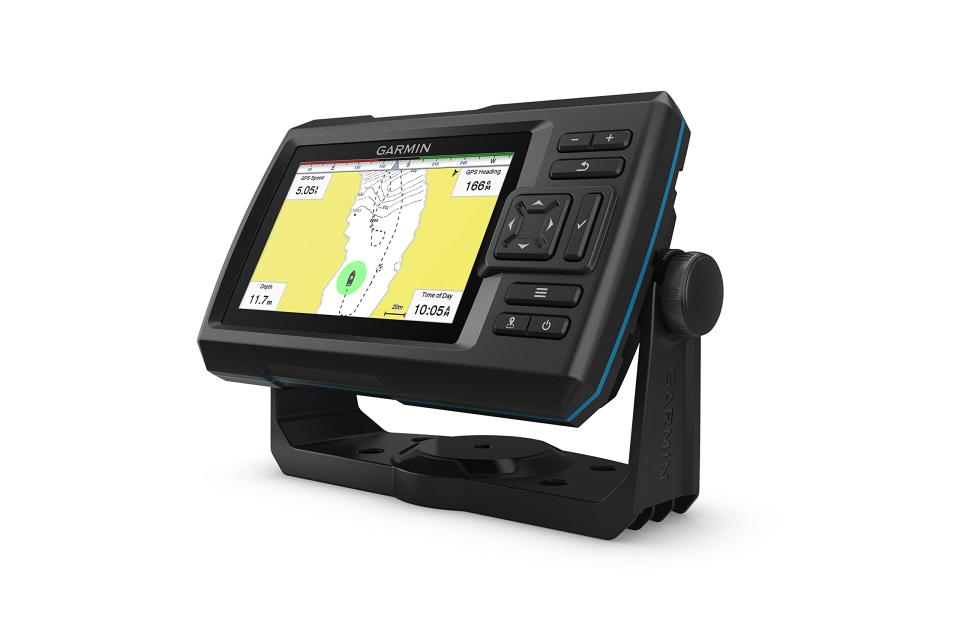
STRIKER Vivid 5cv Fish Finder
$299.99
amazon.com
HOOK2 Fish Finder
Many low-cost fish finders aren’t worth using, but the HOOK2 from Lowrance is a long-running model in the company’s lineup that delivers simplicity and essential functions in an affordable package. The Bullet Skimmer Transducer keeps the cost down but maintains a wide, 40-degree angle to cover more ground beneath your boat to locate fish with less driving around.
The form factor works well for small boats and kayaks. Despite the low price, it comes with all the required mounting hardware. Designed for simple set-up and use, it employs auto-tuning sonar for anglers that aren’t comfortable fiddling with settings to get the perfect display picture.
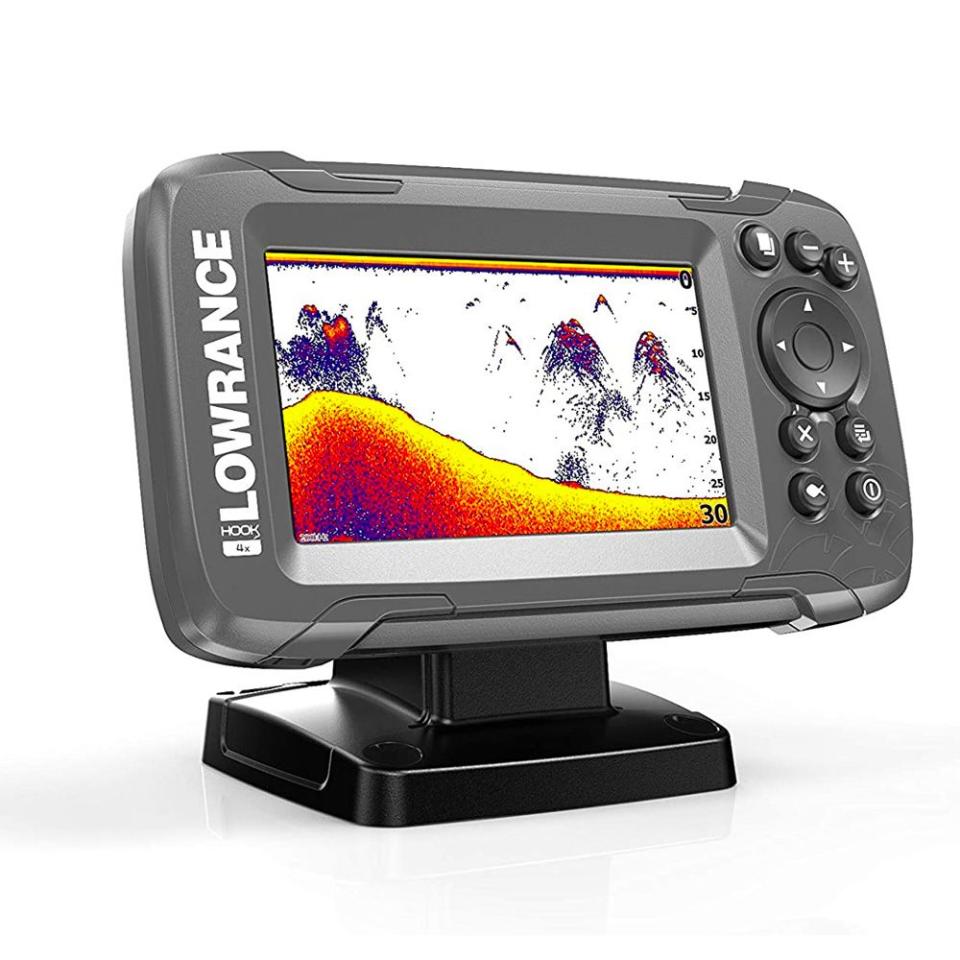
HOOK2 Fish Finder
$95.00
amazon.com
NSS16 Evo3S 16-Inch Fish Finder
If cost is no object, this yacht-ready unit from Simrad pairs a high-definition 16-inch display with advanced functionality for a fish finder that goes far beyond fish finding.
Though it may cost more than many anglers’ boats, the Evo3S offers additional functionality like sound system control and engine monitoring that essentially turns this device into your boat’s command center in addition to a high-end fish finder.
The large high-definition display is easy to read from a distance and is also designed to be readable from different angles as well as while wearing polarized sunglasses. The design also allows for multiple people to view the sonar readout at the same time while actively fishing.
If sharing one screen isn’t sufficient, the unit offers multiple options for connecting additional displays. It comes with the multitasking power to handle it all thanks to an iMX 8 high-performance processor.
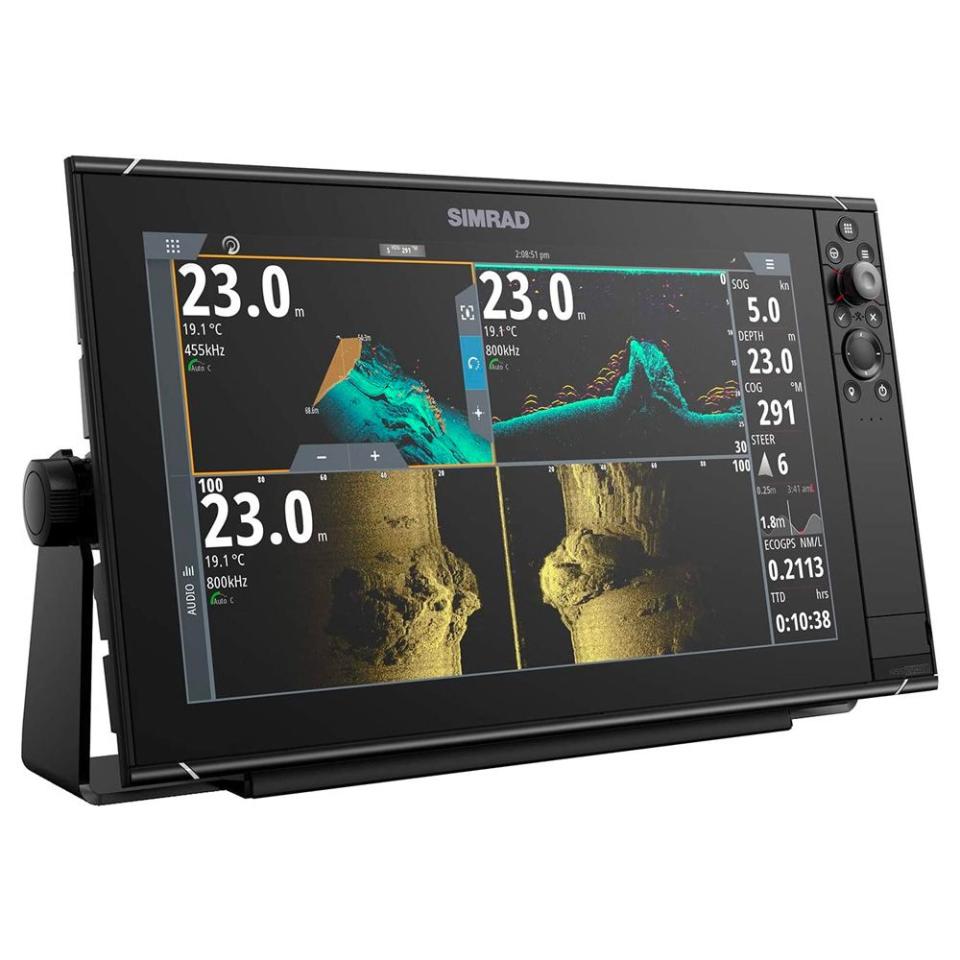
NSS16 Evo3S 16-Inch Fish Finder
$5499.00
amazon.com
Helix 7 MSI G3 Fish Finder
Side imaging is an advanced feature on fish finders that lets you view lifelike pictures of the underwater terrain as you move across the water. This feature will likely bump up the cost of your fish finder, but it’s useful if you’re moving your boat around a body of water trying to identify promising features to explore for fish activity.
There are plenty of units with side imaging for over $1,000, but Humminbird’s 7-inch Helix 7 unit gives you advanced functionality while keeping the price to three digits.
The Helix 7 delivers crisp images of fish and structure, and it also offers impressive connectivity for the price point. It permits connection with third-party map software such as Navionics, and the ability to pair with additional devices such as anchors and other fish finders.
The side imaging shows impressive detail in a wider view but the traditional CHIRP imaging has two modes: a wider view to identify fish and a narrower view to zoom in for more detail.
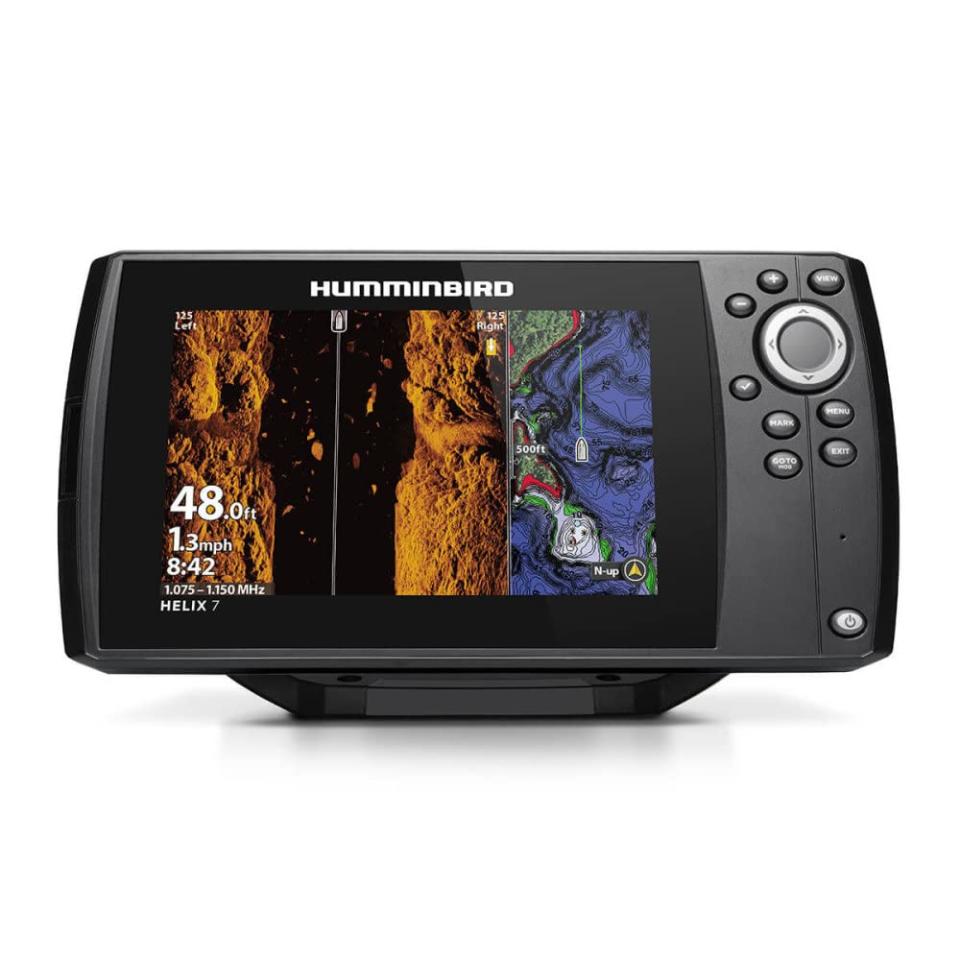
Helix 7 MSI G3 Fish Finder
$517.24
amazon.com
PRO+ Castable Fish Finder
Castable sonar fish finders are a relatively new innovation in the fish finder space, and they make a great option for shore fishing since they don’t require a boat to be effective. They’re also versatile, as they can be deployed from a boat, while ice fishing, from a kayak, and even trolling at slower speeds.
These units are also more affordable than traditional fish finders since they use your smartphone or tablet as their display, removing the substantial cost of the screen. Despite the low cost, however, the Deeper unit employs two beams and creates bathymetric maps of the underwater terrain as well as showing a depth profile with fish and a split-screen option with both at once.
There are some downsides. Because you cast it out on fishing line, it can possibly be lost at sea if your line breaks, and Deeper recommends using at least 16-pound test to ensure that doesn’t happen.
It also means you likely want to dedicate an extra rod and reel to casting the device if you want to be able to use it while fishing, which tacks on an additional cost. You’ll also be subject to the vagaries of a Wi-Fi connection between your phone and the device.
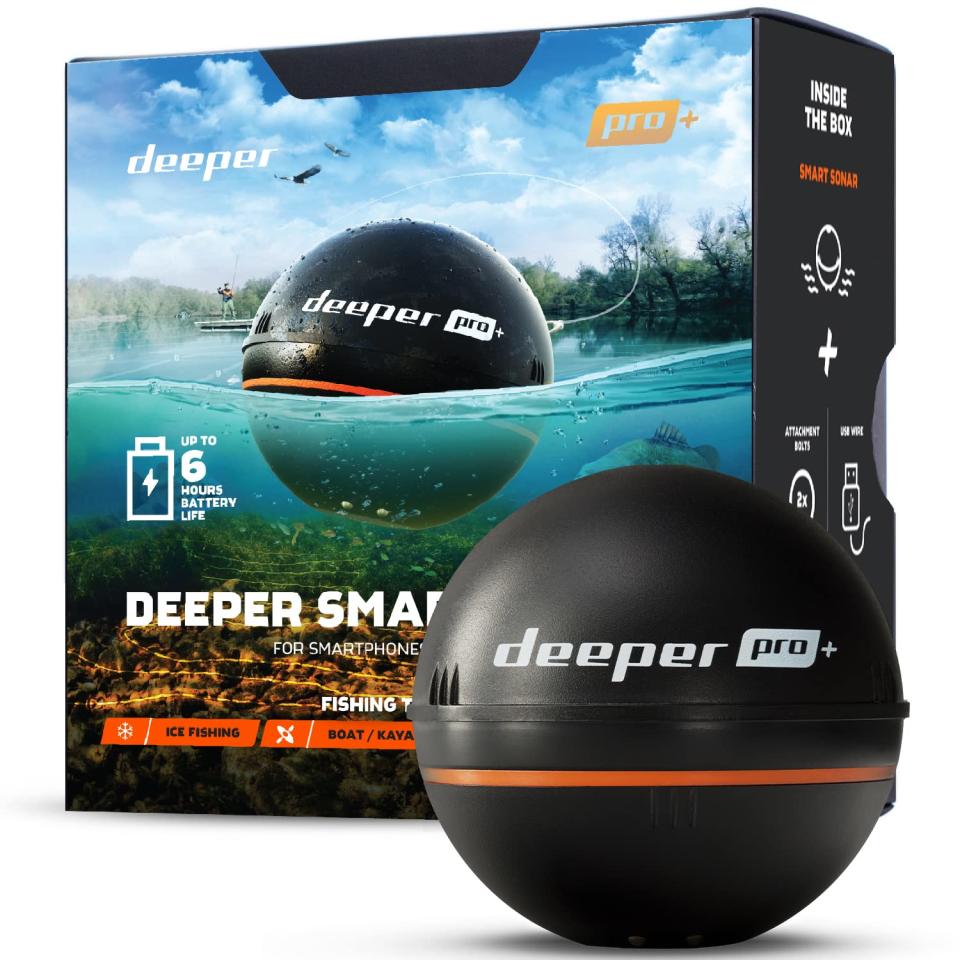
PRO+ Castable Fish Finder
$198.49
amazon.com
Striker Plus 4 Ice Fishing Bundle
Because fish are less active under the ice, finding where the fish are is even more crucial when ice fishing, and thus, a fish finder is truly essential ice fishing equipment. While you can convert your open water fish finder to work on the ice, if you’re serious about ice fishing, it’s simpler to go with a display/transducer combo that’s built to work on the ice right out of the box such as the Garmin Striker Plus 4 Ice Fishing Bundle.
Not only is the transducer built for ice fishing by focusing on a narrow area directly below you, but you also get ice fishing-specific display options tailored to the unique fishing style employed on the ice.
This is a smaller unit, so the biggest drawback is it’s harder to share the screen if you have multiple anglers with lines in the hole. But this is a relatively affordable unit that gives you eyes under the ice with Garmin’s trusted clear imaging and ease of use.
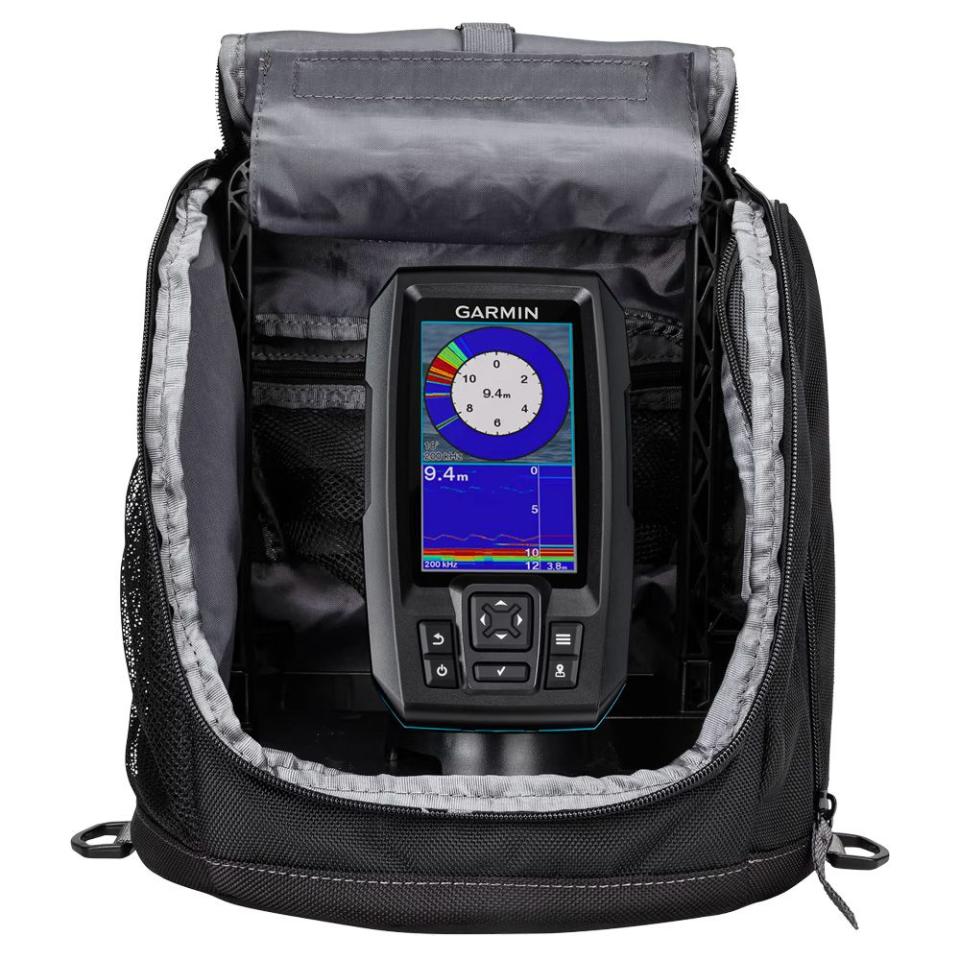
Striker Plus 4 Ice Fishing Bundle
$349.99
basspro.com
Do You Need a Fish Finder? Expert Justin Park Tells You Why You Do and Which to Buy as Your First!
PM: What is the best fish finder for beginners?
JP: Our Best Budget pick above, the Lowrance HOOK2, is also a great option for beginners. The automated sonar tuning makes setup and operation simple for anglers that haven’t spent a lot of time behind a fish finder.
The low cost also makes it easier to get started with fish finding compared to units that run at least $200 and are often harder to use. The display is on the small side as you’d expect for a budget unit, but it’s a proven design that allows beginners get their feet wet to learn the basics of fish finding without a complicated setup.
PM: Will I catch more fish with a fish finder?
JP: While a fish finder is a valuable tool that gives you eyes under the water’s surface, it is no substitute for fishing technique, knowledge, and experience. What a fish finder can do is help you avoid wasting time fishing where there aren’t any fish.
What it cannot do is catch the fish for you, so when buying a fish finder, keep in mind that it’s simply a source of information that can add to your real-time observations of conditions, as well as feedback you get from actually fishing.
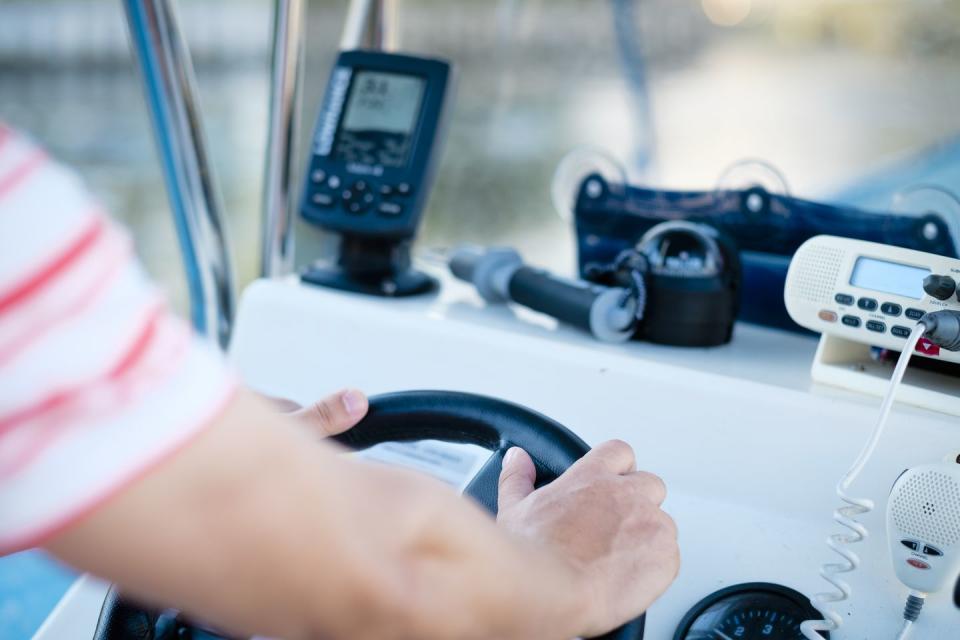
You Might Also Like

